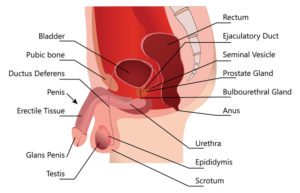It Takes More than a Penis and Vagina
It has come to my attention recently that there are two common words dominating conversations about reproductive anatomy: Penis and Vagina. Now, don’t get me wrong, these are two very key structures that play important roles in reproductive function. But did you know that each of these organs is just one part of a larger system?
The male reproductive system is made up of the testis, scrotum, epididymis, vas deferens, seminal vesicle, prostate, bulbourethral gland, urethra, and penis. The female reproductive system is made up of the vagina, cervix, uterus, fallopian tubes, and ovaries.


The goal of the male reproductive system is to make sperm, keep sperm safe and healthy, and then eventually get sperm out of the body. However, there are a lot of different players involved in this process! Sperm, the male sex cells, are made in the testes. The testes are held safe in a sack of skin, called the scrotum. Right above the testis in the scrotum is the epididymis, which is where the sperm is stored and kept safe before it leaves the body. When a guy gets aroused, and his penis become erect, there is the potential for ejaculation to occur through the penis. This is a process that allows sperm to leave the body. However, the sperm doesn’t just go straight from the Epididymis out of the body, it gets a little help along the way.
Sperm travels from the epididymis through the Vas deferens, a hollow tube that takes it to the urethra. The urethra is the tube inside the Penis that the sperm leaves from. During this journey though the Vas Deferens, sperm mixes with fluids from the bulbourethral gland, seminal vesicle, and prostate. These fluids give sperm fuel, allow them to move more quickly, and protect them from acids that could kill them on their way out of the body. This combination of fluids and many, many sperm is called semen.
Each time ejaculation occurs, about a teaspoon of semen leaves the body, containing about 300 million sperm. If ejaculation occurs inside a female, many of the sperm swim through the female reproductive system, in search of a ripe egg to connect with, which potentially allows pregnancy to happen. Even if ejaculation happens outside but close to the opening of the vagina, sperm can find their way to an egg.
The female reproductive system also has a goal, to allow sperm to meet an egg cell (the female sex cell), and allow for pregnancy to occur. This obviously doesn’t happen all the time. If it did, we’d have a lot more pregnant ladies running around in the world. But that is what the organs are all designed to do, if there is no interference. (This interference is what we call birth control and you can find out more about that here.)
The vagina, the part of this system most people are all familiar with connects the rest of the system to the outside world. It is the way a penis and semen can enter the body, the way that menstrual blood leaves the body, and the way a baby exits the body at the end of a pregnancy.
The cervix is connected to the upper vagina and creates a barrier between the outside world and the inside of the body. It does have an opening though, about the size of the inside of a straw, that lets menstrual blood out, lets sperm in, and widens during child birth to allow a baby to be born.
The uterus, sometimes called the womb, lies past the cervix and is where all the parts of this system come together. The Uterus is where a fetus, and eventually, a baby grows when a woman becomes pregnant. It is very muscular, and can expand a lot to accommodate a growing baby.
The ovaries lie to the sides of the uterus, connected to it by the fallopian tubes. The ovaries hold egg cells, the female sex cells, until they are ready to be released once a month—a process called ovulation. Once an egg cell is released, it is caught by the fallopian tube, which is a skinny tube that allows the egg to travel from its home, the ovary, to the uterus. If there are sperm cells waiting in the fallopian tube, the egg cell can be fertilized, and this is the first step in fertilization. The fertilized egg will travel to the uterus where it spends the next nine months growing into a baby. However, if there are no sperm waiting for the egg, it continues its journey to the uterus by itself. The lining of the uterus then sloughs off, with the unfertilized egg, and leaves the body through the cervix and the vagina. This is called a period.
I hope this helps to clear up any confusion about what organs make up the reproductive systems, where they are, and what they do. Hopefully you now realize that even though the penis and vagina are important, they could never do it alone! Check out www.youngwomenshealth.org for more information about the reproductive system and more.
– Julia

